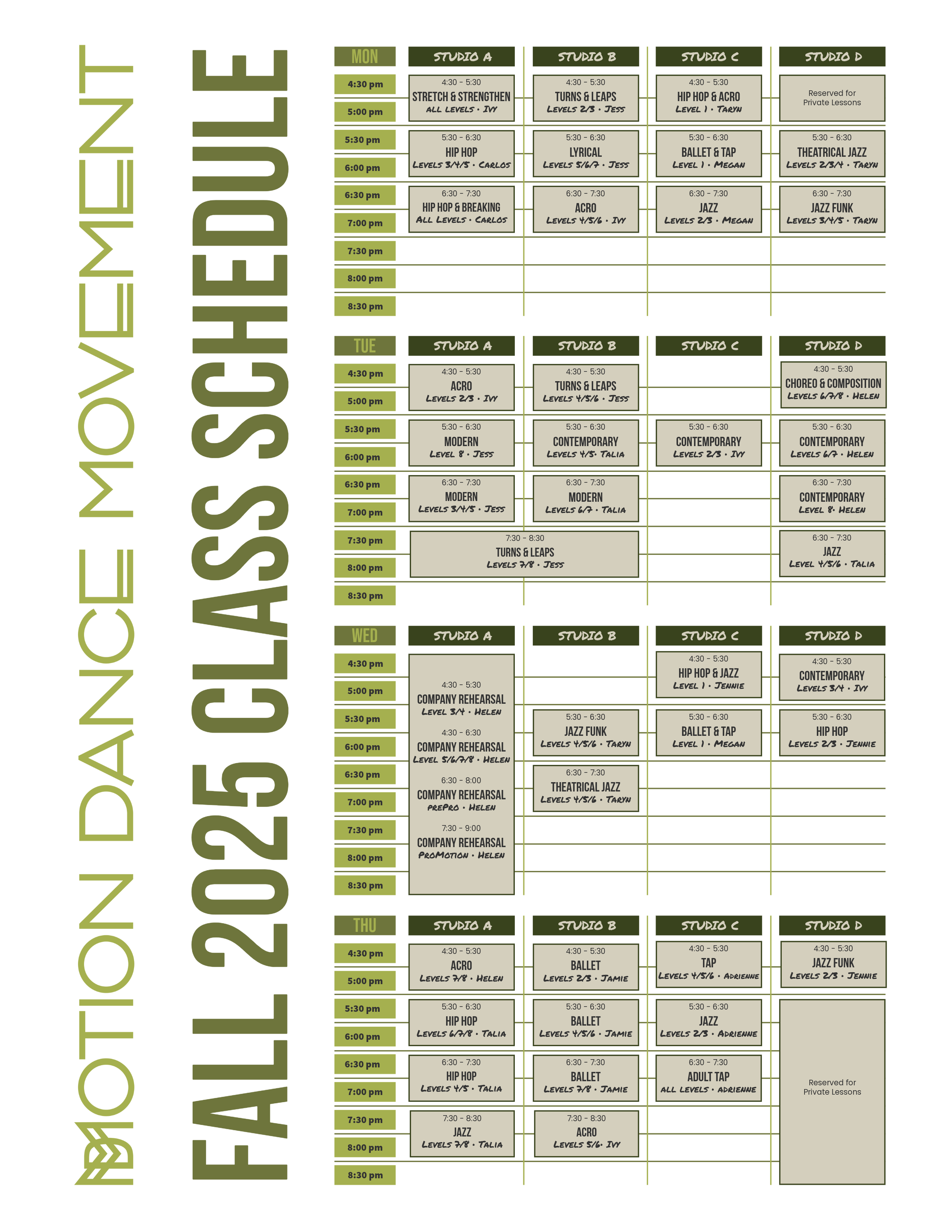CLASSES
Classes at our studio are carefully structured by age and experience to ensure every dancer is placed where they can thrive. Whether your child is just beginning their dance journey or is training at a pre-professional level, our leveled program provides the guidance, support, and challenge they need to grow.
We use a combined level structure, which means dancers may be in class with peers from levels just above or below their current placement. This dynamic setting offers valuable benefits:
It gives dancers the opportunity to step into leadership roles, gaining confidence by mentoring newer peers.
At the same time, they are inspired and motivated by dancers with slightly more experience, who help elevate their technical and artistic development.
We’re committed to fostering growth, confidence, AND a lifelong love of dance at every stage—ensuring that each dancer is both supported and stretched in just the right ways.
LEVELS
ONE • Ages: 3-5 | Experience: 0 - 2 years (beg)
TWO • Ages: 6-8 | Experience: 0-2 years (beg)
THREE • Ages: 8 - 10 | Experience: 2 - 4 years (beg/int)
FOUR • Ages: 11-13 | Experience: 0 - 3 years (beg/int)
FIVE • Ages: 10 - 12 | Experience: 3 - 4 years (int)
SIX • Ages: 12 - 14 | Experience: 3 - 5 years (int/adv)
SEVEN • Ages: 13 & up | Experience: 4 - 6 years (int/adv)
EIGhT • Ages: 14 & up | Experience: 5+ years (adv)
At Motion Dance Movement, we believe it’s never too late to start dancing! Our enrollment is open year-round, so you or your dancer can join a class whenever the time feels right.
-
A fusion of ballet, modern, and jazz, contemporary dance emphasizes emotional expression, fluid movement, and storytelling. Dancers explore floor work, improvisation, and dynamic contrasts in movement.
-
High-energy and rhythm-driven, jazz dance focuses on sharp movements, isolations, and stylized choreography. It builds strength, coordination, and performance skills across a variety of upbeat music styles.
-
Rooted in grounded movement and creative exploration, modern dance emphasizes breath, gravity, and individual expression. It often includes techniques from pioneers like Graham, Horton, or Limon.
-
Ballet teaches posture, technique, discipline, and grace. Students learn classical positions, terminology, and movement vocabulary essential to strong technical development.
-
Tap focuses on creating rhythmic patterns using the feet as percussion instruments. Dancers develop musicality, timing, and coordination through intricate footwork and syncopation.
-
A street-style dance that’s energetic, expressive, and always evolving. Hip hop encourages individuality through freestyle, grooves, and choreography influenced by urban and pop culture.
-
A mix of jazz technique with the attitude and edge of hip hop. Jazz funk is sassy, sharp, and performance-focused — perfect for dancers who love to express personality and style.
-
This technique-based class focuses on improving pirouettes, jumps, and extensions across all styles. Dancers build control, strength, and precision in a non-choreography setting.
-
A Broadway-inspired jazz style that blends dance, character work, and storytelling. Perfect for performers who love musical theatre and want to bring personality and drama to their dancing.
-
Combining dance with tumbling and flexibility skills, acro helps dancers learn safe and seamless tricks like backbends, aerials, and balances. Strength, control, and body awareness are key focuses.
-
A conditioning class designed to improve flexibility, core strength, and overall muscle control. Ideal for injury prevention, technical improvement, and enhancing movement quality across all styles.
-
Blending technique with the emotional expression of contemporary dance, lyrical emphasizes storytelling through movement. Dancers connect deeply to lyrics and musical phrasing, using flowing lines, controlled turns, and expressive gestures to convey meaning.Item description
-
A dynamic street dance rooted in hip hop culture, breakdancing combines athletic power moves, intricate footwork, freezes, and spins. It challenges strength, rhythm, and creativity while encouraging self-expression through freestyle battles and personal style.
-
This class offers dancers the opportunity to explore the art of creating original movement. Through guided instruction, students will learn the fundamentals of choreographic structure, spatial awareness, musicality, and storytelling. Dancers will engage in creative exercises to develop their individual voice and style, while also studying influential choreographers and various compositional techniques.
Throughout the course, students will collaborate, experiment, and receive feedback as they work toward crafting original pieces. Each dancer will have the opportunity to choreograph and set work on their peers, gaining valuable experience in leadership, communication, and artistic direction. This is a supportive and inspiring space where dancers grow not only as performers, but as creators.
class descriptions
ATTIRE GUIDELINES
At MOTION DANCE MOVEMENT, we believe dancers perform their best when they feel comfortable, confident, and free to move. Our dress code supports safety, mobility, and self-expression while maintaining professionalism and discipline in the classroom.
-
Dancers should wear non-restrictive clothing that allows for full range of motion.
Outfits should be form-fitting enough for instructors to observe alignment and technique (especially in styles like ballet, jazz, and acro).Hair should be pulled back neatly and securely away from the face.
No jewelry or accessories that could be distracting or cause injury.
-
Loose-fitting, street-style clothing (sweatpants, joggers, T-shirts, etc.).
Clean sneakers with non-marking soles are required—no street shoes on the dance floor.
Avoid tight clothing that restricts hip-hop-style movement.
-
Tight-fitting attire such as leotards, unitards, or snug tank tops and leggings/shorts.
No loose clothing that may shift or cover the face when upside down.
Bare feet only—no shoes, socks, or half-soles in acro classes.
-
Dancers may dance barefoot or wear appropriate footwear depending on the class style — including ballet shoes, jazz shoes, half soles, or, in some cases, socks.
We believe that dance is a powerful form of self-expression—and what you wear can be too. Dancers are welcome to express their individuality through their clothing, as long as it allows for safe and comfortable movement.
Sweatpants, leggings, athletic shorts, t-shirts, and tank tops are all great options.
We want every dancer to feel confident, free, and authentically themselves in the studio.




